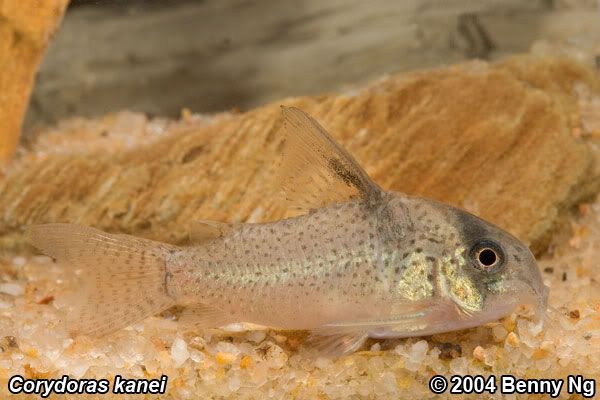Page 1 of 1
Corydoras kanei?
Posted: 08 Aug 2004, 19:27
by benny
Hi guys,
Just wanted to find out if these two are indeed
Corydoras kanei.

This specimen has spots on the head.

This specimen has NO spots on the head.
Could the cory on the top be
Corydoras sp. C26? Or are they (C46 & C26) the same fish.
Advice appreciated. Thanks!
Cheers,
Posted: 08 Aug 2004, 21:35
by Silurus
Corydoras kanei, C26 and C46 are the same thing. Your first fish is C. kanei. I'm not sure that your second is.
Posted: 09 Aug 2004, 09:26
by Fish Demon
The second fish looks a lot like some corys I got about a month ago...
Couldn't get a positive ID on them, but I think they are
C. atropersonatus.

Posted: 09 Aug 2004, 10:14
by jurassic_pork
I agree with HH on this one,The first fish loooks alot like kanei on ian's site the second fish looks totally different though.
Posted: 09 Aug 2004, 11:54
by benny
Hmm..Corydoras atropersonatus have clear caudal and dosal fins. The second fish above has marked fins. So that rules out Corydoras atropersonatus. Unfortunately, I do not have any information on where the fish was imported from.
In another literature, I do see a picture of Corydoras orphnopterus, but this species have a dosal blotch.
By the way, on Ian's site, C26 and C46 shows different markings on the fishes, one with spotted markings on the the head, while the other without. So I'm also confused as to whether both the fishes are actually Corydoras kanei.
Cheers,
Posted: 09 Aug 2004, 17:07
by Coryman
What we are looking at here are possibly the two extremes of the colour pattern of the species. Although the first picture appears to show a shoulder bar below the first three dorsal rays, does this actually show or is it a light thing that has shown from flash photography?
Like most spotted and blotched species there will be a variation in colour pattern and to add even more confusion the colour patter of each individual specimen will change throughout its growing span, that is to say the colour pattern will be fixed only when the fish has stopped growing.
Ian
Posted: 10 Aug 2004, 10:59
by benny
Hi Ian,
Thanks for the comments.
My initial suspicion was that these are two extreme variations of the same species. However, I do realise that there are some with spots on the head while others are without the spots. The pictues in your site (C26 & C46) being one example.
Do you think C26 and C46 are the same species (i.e.
Corydoras kanei)?
As for the black shoulder bar, it's on the fish. Not a shadow or some light reflection caused by the flash during photography.
Here's another piece with dorsal marking, but does not extend into the body. No spots on the head either.

In summary, I would like to seek opinions if
Corydoras kanei has spots on the head. Does anyone here have access to the scientific papers describing this species?
Thanks!!
Cheers,
Posted: 10 Aug 2004, 12:39
by Silurus
What we are looking at here are possibly the two extremes of the colour pattern of the species
I thought about that briefly, then discounted it for several reasons:
1. The dorsal-to-adipose distance is shorter in the second fish (the one with thew non-spotted head), this makes the fish look a little more squat.
2. The top of the snouts slope differently. Presumably, this can be translated into differing shapes of the mesethmoid.
3. It appears that the cleithral (humeral) processes are not exactly the same shape in both fish.
Having no idea of the extent of intraspecific variation in
Corydoras, I do not know whether these would make them two species. I do know that such differences in many other catfish groups would.
Posted: 12 Aug 2004, 05:07
by benny
Hi Silurus,
That's quite a bit to digest...
By the way, what's cleithral (humeral) processes? Care to point me somewhere where I can read up more?
As for the top of the snout, we often see some corydoras (e.g. Corydorus aeneus/paleatus) having a deeper body, kind of like having a hunched back. This makes the snout slopes differently. I know for sure that the second fish was on a very very rich diet. Could it be just plain fat? The third cory is much closer the the second one, but unfortunately the profile is not ideal. I thought it looks quite similar in body shape to the first one.
Further comments?
Cheers,
Posted: 12 Aug 2004, 11:27
by Silurus
what's cleithral (humeral) processes?
It's that bony plate you see just above the base of the pectoral spine.




